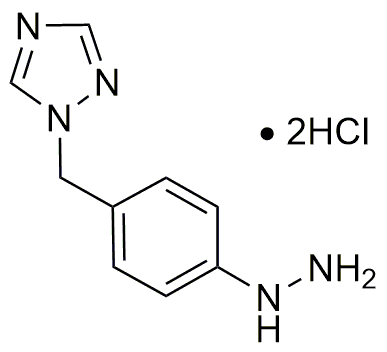1-(4-Hydrazinobenzyl)-1H-1,2,4-triazole dihydrochloride is widely utilized in research focused on:
- Agricultural Chemistry: This compound is explored for its potential as a fungicide, helping to protect crops from fungal infections, thereby enhancing agricultural productivity.
- Pharmaceutical Development: It serves as a key intermediate in synthesizing various pharmaceuticals, particularly in developing anti-cancer agents, due to its ability to inhibit specific cellular pathways.
- Material Science: Researchers are investigating its properties for creating novel materials with unique thermal and electrical conductivity, which can be beneficial in electronics.
- Biochemical Research: The compound is used in studies related to enzyme inhibition, providing insights into metabolic pathways and potential therapeutic targets.
- Environmental Science: It is being evaluated for its role in developing eco-friendly pesticides, aiming to reduce the environmental impact of traditional chemical treatments.
General Information
Properties
Safety and Regulations
Applications
1-(4-Hydrazinobenzyl)-1H-1,2,4-triazole dihydrochloride is widely utilized in research focused on:
- Agricultural Chemistry: This compound is explored for its potential as a fungicide, helping to protect crops from fungal infections, thereby enhancing agricultural productivity.
- Pharmaceutical Development: It serves as a key intermediate in synthesizing various pharmaceuticals, particularly in developing anti-cancer agents, due to its ability to inhibit specific cellular pathways.
- Material Science: Researchers are investigating its properties for creating novel materials with unique thermal and electrical conductivity, which can be beneficial in electronics.
- Biochemical Research: The compound is used in studies related to enzyme inhibition, providing insights into metabolic pathways and potential therapeutic targets.
- Environmental Science: It is being evaluated for its role in developing eco-friendly pesticides, aiming to reduce the environmental impact of traditional chemical treatments.
Documents
Safety Data Sheets (SDS)
The SDS provides comprehensive safety information on handling, storage, and disposal of the product.
Product Specification (PS)
The PS provides a comprehensive breakdown of the product’s properties, including chemical composition, physical state, purity, and storage requirements. It also details acceptable quality ranges and the product's intended applications.
Certificates of Analysis (COA)
Search for Certificates of Analysis (COA) by entering the products Lot Number. Lot and Batch Numbers can be found on a product’s label following the words ‘Lot’ or ‘Batch’.
*Catalog Number
*Lot Number
Certificates Of Origin (COO)
This COO confirms the country where the product was manufactured, and also details the materials and components used in it and whether it is derived from natural, synthetic, or other specific sources. This certificate may be required for customs, trade, and regulatory compliance.
*Catalog Number
*Lot Number
Safety Data Sheets (SDS)
The SDS provides comprehensive safety information on handling, storage, and disposal of the product.
DownloadProduct Specification (PS)
The PS provides a comprehensive breakdown of the product’s properties, including chemical composition, physical state, purity, and storage requirements. It also details acceptable quality ranges and the product's intended applications.
DownloadCertificates of Analysis (COA)
Search for Certificates of Analysis (COA) by entering the products Lot Number. Lot and Batch Numbers can be found on a product’s label following the words ‘Lot’ or ‘Batch’.
*Catalog Number
*Lot Number
Certificates Of Origin (COO)
This COO confirms the country where the product was manufactured, and also details the materials and components used in it and whether it is derived from natural, synthetic, or other specific sources. This certificate may be required for customs, trade, and regulatory compliance.


